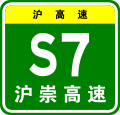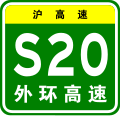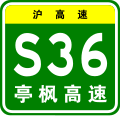Top Qs
Timeline
Chat
Perspective
Expressways of Shanghai
Overview of transport in Shanghai From Wikipedia, the free encyclopedia
Remove ads
Shanghai has an expansive grade-separated highway and expressway network consisting of 16 municipal express roads, 10 provincial-level expressways, and 8 national-level expressways. Three municipal expressways and four provincial-level expressways are also under construction.
This article has multiple issues. Please help improve it or discuss these issues on the talk page. (Learn how and when to remove these messages)
|

Remove ads
Municipal express roads
Summarize
Perspective
Most municipal express roads are found in the inner districts of Shanghai, including several elevated highways which run directly above surface-level roadways. In Chinese, these expressways are literally termed city high-speed roadways (Chinese: 城市快速道路), and their maximum speed is typically 80 kilometres per hour (50 mph). These are still considered expressways or controlled-access highways because of the presence of ramps, grade-separated junctions, and the absence of traffic lights. Most of these expressways are elevated and run above a lower-speed roadway. The Inner Ring Road is a beltway, while the Middle Ring Road, is also a beltway.
Primary express roads
These are primary express roads that form a major backbone of expressways within the city core. Of these four, the Inner Ring, North–South, and Yan'an Elevated Roads form a 申 (a Chinese abbreviation for Shanghai) shape. The Middle Ring forms a second orbital surrounding the Inner Ring Elevated Road, and is fully complete. The 申 shape was originally partial until the recent completion of the Pudong Avenue Ground Way.
Auxiliary express roads
These are other express roads that serve as part of the municipal expressway network. Of these, six belong to the Hongqiao Comprehensive Transportation Hub, a network of municipal expressways serving Shanghai Hongqiao Railway Station and Shanghai Hongqiao International Airport.
Restrictions on Driving
In Shanghai, there are restrictions on foreign license plates, temporary license plates, drivers with probationary licenses, and taxis not carrying passengers to drive on many municipal elevated roads. This ban is enforced by the police, and affects every day except Saturday, Sunday, and public holidays. They came into effect on November 2020.[1][2]
The affected expressways include:
1. Municipal freeways, from 7:00 to 20:00 daily
- Yan'an Elevated Road (entire route)
- North-South Elevated Road (400m section south of Huma Road and Luheng Road, including Lupu Bridge)
- Yixian Elevated Road (entire route)
- Shanghai-Minhang Elevated Road (entire route)
- Middle Ring Road (entire route)
- Huaxia Elevated Road (entire route)
- Luoshan Elevated (entire route)
- Dujia Elevated Road (from Middle Ring Road to Xiupu Road)
- Inner Ring Elevated Road (including Nanpu Bridge, except the section from the inner ring Zhongshan North 2nd Road entrance to the Jinxiu Road exit and the outer ring Jinxiu Road entrance to the Huangxing Road exit)
- Longdong Elevated Road (from Luoshan Road Interchange to S20 Outer Ring Expressway)
- Hongmei Elevated Road (from Middle Ring Road to S20 Outer Ring Expressway)
- Beidi Road Tunnel
- Yan'an East Tunnel
- Beiheng Passageway (from Beihong Interchange to Tianmu Interchange and the grounding point at Wen'an Road).
2. Inner Ring, 7:00 to 9:00 and 17:00 to 19:00
Furthermore, there is a prohibition affecting the same categories, within any point inside the Inner Ring Elevated Road and the roads it is with.
Remove ads
Provincial expressways
Summarize
Perspective
Designations for provincial-level and federal-level expressways in Shanghai had the letter prefix A before the number of the expressway. Starting at the Yingbin Expressway, which was designated the number 1, the numbers increased clockwise around the city. For ring expressways, the designations A20, A30, A40, etc., were used. For expressways connecting to other provinces which already had national designations (beginning with the letter G), designations with the letter A were attached.
In August 2009, Shanghai replaced its system of naming expressways with the prefix A with the letter prefix S, in order to conform to the standard designations for provincial-level highways within China. The S means Shengdao, or provincial-level roads. The letter prefix A was abolished.
Remove ads
National expressways
Summarize
Perspective
National highways and expressways in Shanghai both have the prefix G, an abbreviation for Guodao (国道), which literally means National roads. It is important to note that both grade-separated, controlled-access expressways and normal at-grade highways both have the prefix G. Only the national-level expressways are mentioned here. National-highways which are at grade and not controlled-access are also found in Shanghai, and these include ![]() G204,
G204, ![]() G312,
G312, ![]() G318, and
G318, and ![]() G320. Expressways also have green-coloured signs while their highway counterparts have red-coloured signs.
G320. Expressways also have green-coloured signs while their highway counterparts have red-coloured signs.
Yangtze River fixed crossing
Shanghai has one bridge-tunnel crossing spanning the Yangtze Delta to the north of the city. The G40 Shanghai–Xi'an Expressway follows the Shanghai Yangtze River Tunnel from Pudong to Changxing Island, and then over the Shanghai Yangtze River Bridge from Changxing to Chongming Island and finally via the Chongming–Qidong Yangtze River Bridge from Chongming to Qidong in Jiangsu Province on the north bank of the river. A second fixed crossing is planned to the west of this bridge, and will become part of the S7 Shanghai–Chongming Expressway.
Remove ads
Notes
References
Wikiwand - on
Seamless Wikipedia browsing. On steroids.
Remove ads
























